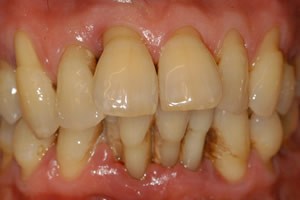Header logo
header top contact widget
Learn More Blog
Rheumatoid Arthritis (RA) Linked To Periodontal Disease
Posted on Oct 02, 2019 by William J. Claiborne, DDS MS
 As a periodontist, I specialize in the treatment of all stages of periodontal (gum) disease. Although this particular dental specialty is not as visible as a general dentist, we are very-involved members of the medical and dental community. According to the Centers for Disease Control & Prevention (CDC), over 47 percent of American adults have some level of gum disease.
As a periodontist, I specialize in the treatment of all stages of periodontal (gum) disease. Although this particular dental specialty is not as visible as a general dentist, we are very-involved members of the medical and dental community. According to the Centers for Disease Control & Prevention (CDC), over 47 percent of American adults have some level of gum disease.
Like the formation of cancer, many individuals are unaware when periodontal disease becomes active. When early symptoms appear (such as bleeding gums when brushing, bad breath and gum tenderness), many people shrug them off as temporary.
However, gum disease only progresses once underway. Eventually, gums become red in color and pus pockets form at the base of teeth. In advanced stages, teeth loosen and may require removal. Gum disease, to no surprise, is the nation’s leading cause of adult tooth loss.
The potent bacteria of periodontal disease can enter the bloodstream through tears in weakened gum tissues. This allows it to travel throughout the body. Research has shown it is able to trigger a number of serious health problems, including heart disease, stroke, diabetes, memory loss, and impotency.
Rheumatoid arthritis (RA), a condition seemingly unrelated to gum disease, is a debilitating disease that destroys joints. It is disabling and painful. In most cases, RA emerges gradually, often beginning with morning stiffness along with weak and aching muscles. Joint pain follows, with joints feeling sore and stiff. RA is typically found in the fingers, wrists, elbows, hips, knees, ankles, toes, shoulder and neck.
As inflammation from RA increases, joints become swollen with symptoms including fever, disfiguring of hands and feet, numbness and tingling. There is no cure for RA and lifelong treatment is required. Treatment may consist of medications, physical therapy, or even surgery.
Yet, like RA, gum disease causes pain, swelling, and tenderness. As it worsens, the associated inflammation can lead to destruction of the bone that supports teeth along with surrounding tissues. And, the similarities go much deeper.
Both gum disease and RA share a genetic likeness in clinical makeup and structures. This has been particularly apparent in pathogens, which are agents in the body that lead to disease or illness. The pathological processes that occurs in both gum disease and RA are almost identical.
Too, the particular species of bacteria found in gum-diseased oral tissues and tissues that surround joints in those who suffer with RA. Equally concerning is, while both conditions clearly cause chronic inflammation in tissues connected to bone, researchers have found the two diseases share a similar inflammatory trigger.
In one study, a particular pathogen associated with periodontal disease was found to activate the same destructive process of rheumatoid arthritis. It has also been shown that, by treating periodontal disease in RA patients, RA symptoms often improve ( likely due to the system’s reduced burden of oral inflammation).
These findings reveal just how closely our oral health correlates

A relaxing and comfy environment.
to our overall health. This information should send up alarms that the presence of gum disease can greatly increase your risk for serious health conditions. Clearly, people who have RA should be particularly diligent when it comes to their oral health.
If you are experiencing symptoms of gum disease (as mentioned above), seek treatment at your earliest convenience. You can begin with a consultation appointment in our comfortable Asheville periodontal office. A referral is not needed.
Call 828-274-9440 to learn more.
Recent Posts
Categories
Archives
- September 2024
- August 2024
- July 2024
- June 2024
- May 2024
- April 2024
- March 2024
- February 2024
- January 2024
- December 2023
- November 2023
- October 2023
- September 2023
- August 2023
- July 2023
- June 2023
- May 2023
- April 2023
- March 2023
- February 2023
- January 2023
- December 2022
- November 2022
- October 2022
- September 2022
- August 2022
- July 2022
- June 2022
- May 2022
- April 2022
- March 2022
- February 2022
- January 2022
- December 2021
- November 2021
- October 2021
- September 2021
- August 2021
- July 2021
- June 2021
- May 2021
- April 2021
- March 2021
- February 2021
- January 2021
- December 2020
- November 2020
- October 2020
- September 2020
- August 2020
- July 2020
- June 2020
- May 2020
- April 2020
- March 2020
- February 2020
- January 2020
- December 2019
- November 2019
- October 2019
- September 2019
- August 2019
- July 2019
- June 2019
- May 2019
- April 2019
- March 2019
- February 2019
- January 2019
- December 2018
- November 2018
- October 2018
- September 2018
- August 2018
- July 2018
- June 2018
- May 2018
- April 2018
- March 2018
- February 2018
- January 2018
- December 2017
- November 2017
- October 2017
- September 2017
- August 2017
- July 2017
- June 2017
- May 2017
- April 2017
- March 2017
- February 2017
- January 2017
- December 2016
- November 2016
- October 2016
- September 2016
- August 2016
- July 2016
- June 2016
- May 2016
- April 2016
- March 2016
- February 2016
- January 2016
- December 2015
- November 2015
- October 2015
- September 2015
- August 2015
- July 2015
- June 2015
- May 2015
- April 2015
- March 2015
- February 2015
- January 2015
- December 2014
- November 2014
- October 2014
- September 2014
- August 2014
- July 2014
- June 2014
- May 2014
- April 2014
- March 2014
- February 2014
- January 2014
- December 2013
- November 2013
- October 2013
- September 2013
- August 2013
- July 2013
- June 2013
- May 2013
- April 2013
- March 2013
- February 2013
- January 2013
- December 2012
- November 2012
- October 2012
- September 2012
- August 2012
- July 2012
- June 2012

